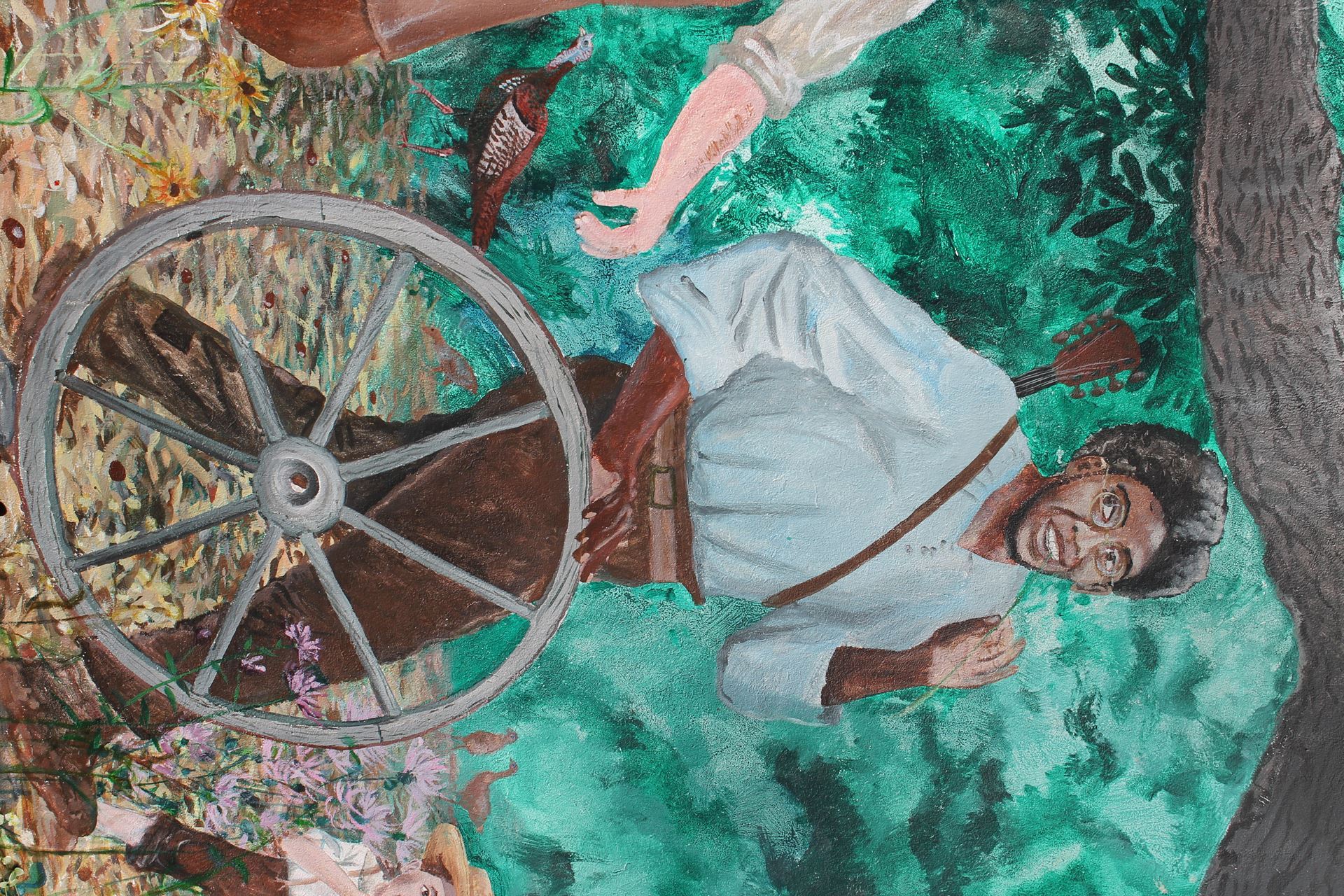- Home
- Black History Month
BLACK HISTORY MONTH
FEBRUARY
Black Americans have lived in Tompkins County since the early 1800's. In 1820 the Black population of Ithaca numbered only nine people, although more enslaved Black people lived and worked in the rural regions of the county. Slavery was abolished in New York State in 1827. The free Black population in the City of Ithaca began to grow in the early 1800s as more families and individuals self-liberated from slavery in the Southern states and traveled North on the Underground Railroad, which had multiple stations and checkpoints in Tompkins County. With the addition of passengers from the Underground Railroad, Ithaca's Black population grew to over 200 by 1860, and the Black neighborhoods of Southside and along Wheat Street (now Cleveland Avenue (Zoom in on HistoryForge to see all the Black households along Wheat Street in 1900)) became established in the community. Tompkins County has been home to many trailblazing Black Americans, including: Civil Rights leader Dr. Dorothy Cotton, Pulitzer Prize winner Alex Haley, Nobel Prize winner Toni Morrison, Ruth Carol Taylor - the first Black flight attendant in the United States - and many more phenomenal leaders of the Black community locally, nationally, and globally. We encourage everyone to engage with and learn about the rich history of Black residents in Tompkins County. | .jpg) Peter & Phyllis Webb were born enslaved and brought to the Town of Caroline as children. They married in 1819. Peter purchased his freedom in 1818 for $350; Phyllis remained enslaved until New York abolished slavery in 1827. Their descendants still live in Tompkins County. Learn more: Webb Family History. |
Learn more about Black history in Tompkins County from our online resources, in our Exhibit Hall, by exploring our Black History Collection in the archives, and through visiting historic Black spaces in Tompkins County. Connect with our archivist to contribute to the archival collections documenting Black history in Tompkins County, the HistoryForge database, and the Black Lives Matter Archival Collection established in June of 2020. |
2024 BLACK HISTORY IN TOMPKINS COUNTY EXHIBIT
Local Baseball: America's Pastime - part of 'A Sporting Chance: On and Off the Field'
The Colored Vets, later called The Zebras came from a long tradition of Black baseball teams in Ithaca. From the 1880s to the early 1900s, Black teams such as Forest City, the Keystones, and the Ithaca Colored Nine/Ithaca Giants played Black and white regional teams. In the early 1930s, the Keystones and the Red Caps became the first Black teams in the City League. The Vets/Zebras played in the City and Inter-County Leagues. Learn more about this history through visiting 'A Sporting Chance' in person. On display February-December 2024. |
|
PRESENTATIONS & ONLINE LEARNING RESOURCES
|
|
|
|
|
|
EXPLORE ITHACA'S BLACK NEIGHBORHOODS ON HISTORYFORGE
HistoryForge is an innovative digital history project combining maps, archival records, and census data that allows any community to explore its local history through the individuals who lived there and the buildings and neighborhoods they lived in. Our pilot project began in 2016 and focuses on exploring the history of Ithaca, New York in the late 19th and early 20th century using interactive search functions which allow users to find information on historic maps about people and places. Tompkins County HistoryForge includes over 100,000 digitized census records of Tompkins County residents from 1880-1950, and is in the process of expanding to the rest of the county. By searching the database using the "Race" filter on different census years you can see where Black neighborhoods existed in the City of Ithaca. | Each red dot references a self-identified Black individual or family living in the building in the 1930 census. The area shown is the Southside Neighborhood. You can see the names, ages, professions and more of each individual by exploring their census records. |

Sisters of Change exhibit at The History Center in Tompkins County - January 2020
Artist interpretation of Lloyd Dorsey, believed to be the first Black man to vote in the Town of Ulysses. Mural located in Trumansburg, NY.
| Visit The History Center in Tompkins County and explore our displays on Black history. Private visits can be scheduled in advance at thehistorycenter.net/schedule. Also available is the virtual exhibit Sisters of Change: Unsung Sheroes Whose Names You Ought to Know. This virtual exhibit honors the life of Civil Rights leader and local icon Dorothy Cotton, and 25 other women who fought for voting and civil rights across the country. St. James AME Zion Church - Ithaca, NY - St. James AME Zion, built in 1833, is believed to be the oldest church structure in Ithaca and one of the first AME Zion churches in the country. St. James served as a station on the Underground Railroad, and famous Underground Railroad station masters were closely associated with the church; Harriet Tubman played an active role in AME Zion church affairs in Central and Western New York, and often visited St. James. Frederick Douglass is documented as visiting the church in 1852, and Jermain Loguen, who served as St. James' third minister, was known as the "Underground Railroad King" for his prolific abolitionist efforts, which helped liberate hundreds of formerly enslaved people. Explore the Southside neighborhood around St. James on HistoryForge to see names and stories of the Black community in the early twentieth century. Lloyd Dorsey Historical Marker - Trumansburg, NY - Lloyd Dorsey self-liberated from enslavement in Maryland to freedom in Trumansburg in the early 1840s. His wife-to-be, Nancy M. Hemans, was a free Black woman from the Town of Caroline who moved to Trumansburg and was enrolled in the First Baptist Church of Trumansburg in 1839. She and Lloyd were married in 1844. Lloyd worked as a carter hauling goods by horse and wagon in and around Trumansburg for hire, and Nancy worked as a laundress and domestic. Together they had nine children. In 1851 they purchased “an acre of land with appurtenances” for $430 from Erastus and Mary Treman. Lloyd is believed to be the first African American to vote in the Town of Ulysses. At that time, Black males were required to own property valued at a minimum of $250 in order to vote. Southside Community Center - Ithaca, NY - Southside House began as the idea of the Frances Harper Women's Club. Inspired by the life of Francis Ellen Watkins Harper (1825-1911), an abolitionist, activist, poet, and a founder of the National Association of Colored Women, members first held mother-daughter dinners, then moved on to organizing "community mothering activities." In 1930 they became the Serv-Us League, opening membership to males. An interracial fundraising effort raised the money by 1932 to buy a house at 305 South Plain Street. After the Serv-us League deeded the property to the City of Ithaca, ground was broken in 1936 for the Southside Community Center. First Lady Eleanor Roosevelt attended the 1937 dedication. Southside Community Center continues to be an active community resource center, fostering appreciation for the contributions and presence of peoples of African descent in the greater Ithaca community and in the larger world community. Birthplace of Alex Haley - Ithaca, NY - Alex Haley (1921-1992) is a celebrated author, best known for his 1967 book Roots: The Saga of an American Family, and The Autobiography of Malcolm X. Haley was born in Ithaca on August 11, 1921 at 212 Cascadilla Street. Haley’s father was a graduate student at Cornell University and his mother was taking music studies courses at the Ithaca Conservatory of Music, the institution that later became Ithaca College. In 1993, a year after his death, the Alex Haley Memorial Project raised funds to create a memorial pocket park at the home of his birth on Cascadilla Street. A carved granite marker, and a hand-wrought iron bench with individual iron leaves made by community members with the assistance of local blacksmith Durand Van Doren, were also installed in the park. A New York Historical Marker funded by the Pomeroy Foundation was placed outside his birthplace in August 2020 during a local unveiling ceremony honoring his life and legacy. Dennis-Newton House - Alpha Phi Alpha - Ithaca, NY - The Dennis-Newton House at 421 North Albany Street in Ithaca, NY is historically significant on a national level for its direct connection to the early formation of the Alpha Phi Alpha fraternity, the first Greek letter, African-American collegiate fraternity in the United States. Alpha Phi Alpha was established in 1906 by seven Black Cornell University students. There are over 850 chapters of the fraternity located around the world today. Learn more. Gravesite for Dr. Dorothy Cotton - Pleasant Grove Cemetery - Dr. Dorothy Lee Forman Cotton (1930-2018) met Dr. Martin Luther King Jr. in 1960 when he preached at a church she attended in Virginia. The two began working together with the Southern Christian Leadership Conference, which organized peaceful protests and worked for the rights of Black Americans during the Civil Rights era. Cotton held a leading role in the group as the educational director of the Citizen Education Program ― one of the few high-level positions for women in the SCLC at the time. Dorothy remained an active civil rights educator throughout her career, and served as the Director of Student Activities at Cornell University from the 1980s–1990s. She lived in Ithaca until her death in 2018, and is buried in the Pleasant Grove Cemetery in Ithaca, NY. |
.png)





.png)
.png)
.png)
.png)

 St. James AME Zion Church in 1836 - Ithaca, NY.
St. James AME Zion Church in 1836 - Ithaca, NY. 












